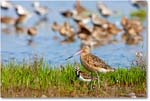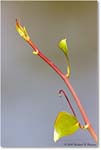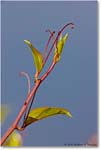
Chincoteague > May 2009
info@GrayFoxImages.com

Chincoteague > May 2009 |
|
Michael W Masters
info@GrayFoxImages.com |
| Image Thumbnails |
|
Among the biggest draws at Chincoteague NWR are the wild ponies. There are two separate bands, one of which is on the west side of the beach road, behind a fence such that visitors can see but never get close to them. The other band has complete freedom to roam throughout the rest of the island. Sometimes one never sees this second band, but occasionally they put in an up-close-and-personal appearance, and when they do the ponies become an instant show stopper! Such was the case during this visit. I first noticed a crowd parked along the entrance to the Woodland Trail. The band soon emerged onto the beach road near Egret Alley, my name for the channel that connect Swan Cove to the drainage culvert to Little Tom's Cove. A couple of mares were nursing foals, and yet although plenty of people crowded around the herd the stallion seemed OK with the proceedings. It was difficult to find good shooting angles with so many ponies and people milling about, but the session was great fun nonetheless. Perhaps the next most enjoyable part of the trip was the opportunity to photograph a forster's tern in late afternoon sun. The location was on the shore of a small inlet off Little Tom's Cove that I call Tiny Tom's Cove. This is a great morning location, lit by full frontal sun, and it has provided some of my best imaging opportunities. But, it is usually my last choice in the afternoon since one must shoot directly into the teeth of low elevation solar glare. Conditions were quite poor on this day. A bit of haze rendered the water a bright gray-white in color, leaving the bird in almost total darkness by comparison. It seemed a hopeless situation at first, but upon reflection I took it as an opportunity to experiment with fill flash. I made a number of images at different ambient and flash settings, almost all of them with plus compensation for both ambient and flash exposure. Plus compensation for ambient was a necessity to recreate the bright skyhaze-off-water effect. And, it took a lot of flash power to illuminate the tern satisfactorily. As it turned out, the situation proved to be far from hopeless, and this model has become a favorite for shooting dimly lit subjects against bright backgrounds whenever I encounter them. They can even be found in my back yard. |
 |
 |
 |
 |
 |
 |
 |
 |
 |
 |
 |
 |
 |
 |
 |
 |
 |
 |
 |
 |
 |
 |
 |
 |
 |
 |
 |
 |
 |
 |
 |
 |
 |
 |
 |
 |
 |
 |
 |
 |
 |
 |
 |
 |
 |
 |
 |
 |
 |
 |
 |